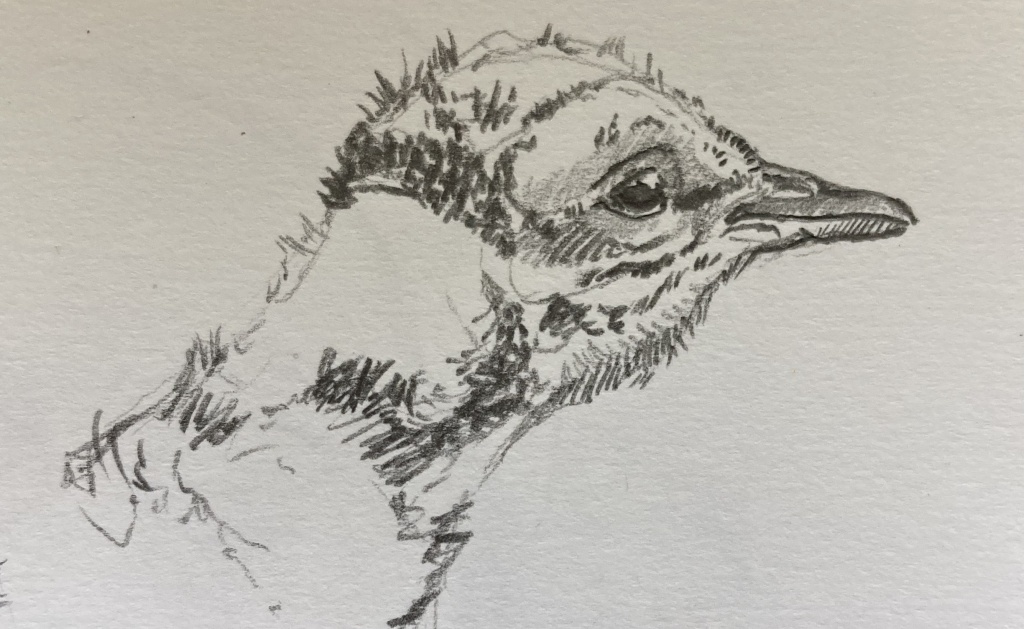
At first I was worried that the lapwings would wear themselves out with the endless bother of protecting their chicks. They were frantic, and even the smallest twitch of a pipit or a wagtail would send them into gales of protective fury. But now that the last surviving chick is seventeen days old, they’re far more blasé about parenting. The youngster is sometimes seventy yards away or more from either parent, and the adult male is often very casual in his steady foraging. The female is frequently invisible; she lies and relaxes on her own in a wheel rut or the gap between two divots – they’re endlessly watchful, but it’s a different and lower gearing of vigilance.
The chick is fun to observe in its blend of hesitancy and boldness. It probes and explores the vegetation keenly for periods of ten or fifteen minutes at a time, then it seems to “power down” for up to an hour in the sunshine. It’s invisible to the naked eye, but the thermal spotting scope reveals that it’s just lying there, either asleep or digesting its most recent bellyful of insects. Of course it helps that the weather has continued to be warm and dry – everything the young bird needs lies within easy reach, so it can afford to be fat and idle. It’s interesting that even as the field withers in the wake of being sprayed off, there’s still more than enough insect life available. A week after spraying, the old grass and brassica stalks look horribly scant and barren – but the birds forage and feed freely. They show no interest in leaving.
As the chick has grown, the list of potential predators has shrunk considerably. It’s probably now too big to be eaten by jackdaws, rooks and carrion crows. It’s unlikely to be targeted by weasels or rats, and it would be very unlucky if a badger caught it. Foxes remain a constant threat, and I feel certain that this entire narrative could end like the flick of a switch if a fox came into this field and made a concerted effort to discover the chick. But I also wonder if there’s virtue in the sheer scarcity of lapwings in this parish. The local foxes will have smelt the adult birds many times since they arrived in March, and they will recognise the scent as something flighty and inaccessible. Perhaps they think it would be nice to catch a lapwing, but the thought is more like a fantasy than a realistic prospect.
Given that lapwings have not nested here for decades, it’s possible that foxes just aren’t geared up to hunt for their chicks – and that if lots of lapwings nested here, the predators would soon learn that their chicks were easily caught. Maybe it also helps that the sprayer effectively deleted odour from this field by masking the place with chemicals. From a fox’s perspective, is it really worth hunting for hours through a strangely-scented mess of mud and straw in search of something you’ve never seen or eaten? These last few nights on my bicycle through the backroads near home, I have seen several foxes out in the long grass eating shit from the newborn calves. That’s a better and more nutrient-rich use of their time, but it plays in the lapwing’s favour only for as long as their chicks remain strange and untested as a foodsource.
Buzzards are a similarly alarming threat, and they’re not restricted by a dependence upon smell. The local buzzards certainly know about this lapwing chick, but they haven’t done anything about it yet. When the raptors land nearby, they’re busily mobbed by the adult lapwings and that has so far been enough to deter them. But it’s a strange imbalance because a buzzard could very easily shove an adult lapwing to one side and eat the chick whenever it chose – they simply don’t seem inclined to make even a small effort in this direction.
The scientists say that when lapwings hatch their chicks, they stop their classic topsy-turvy displays and focus on the wary, warning cry of “peeWIT”. That’s how you know that chicks have hatched, and it’s easy way to infer progress and productivity when the chicks themselves are so difficult to see. But it’s noticeable that after a period without any display-calls, the adult male is back to his old tricks again. If anything, he is more raucous and provocative in his flight displays than he’s ever been, and his calls are an outrageously expanded and continuous remix of the classic early season show. This is either a contradiction of accepted wisdom, or it’s equally possible that he has drawn in a second female to nest in the same field… more exploration is certainly required here.
Walking nearby last night, the male bird came and flew quite low and slowly over my head with his wingbeats staggered and his neck outstretched, saying “I’ve seen you”. There had been a thunderstorm during the day, and the evening light was fresh and golden. Against a backdrop of tall clouds and hawthorn blossom, his approach was downright impish – I felt very aware that he was addressing me directly, man-to-man. Having recently discussed these noisy displays with a friend, I wonder if this behaviour is a chance for him to actively show off to potential predators, distracting their attention onto himself while also expressing his superb fitness and condition, following “I’ve seen you” with “…and you’ll never catch me”.
Leave a comment